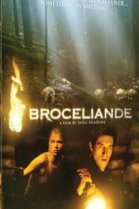
In a cultural age where the film industry languishes in a repetitious cycle of stale re-makes and uninspired, apathetic potboilers more concerned with 'feel good' plot lines and 'political correctness' than with the aesthetics of true emotionally intensive storytelling, the horror genre is hit hardest. Easily its own worst enemy, the genre, once devoted to evoking fear and wonder, is now content (and has been for a long while) to simply cannibalize itself. Small wonder, then, that filmmakers searching for unique themes or fresh interpretations of archetypes so often search through the hoary annuals of mythology, legend, and folklore for inspiration. The earliest literature of our species, myths and folklore offer characters, symbols, and story patterns that prove relevant and enticing to human beings regardless of age or culture, dealing with cosmic themes capable of transcending such limitations. Supernatural horror cinema has been especially bound to oral belief and legends, from the rather cliché and morally simplistic good vs. evil formula inherent in Christian storytelling to the more creative, certainly more ambiguous beliefs of Pagan culture. Whereas such often cited classics as The Exorcist and Rosemary's Baby betray a naïve and irritating emphasis on God and Satan, with little room for moral complexity, films that utilize the morally shadowy themes of Pagan belief to arouse terror make possible a more believable context with which to explore not only evil vs. goodness, but the ambiguous borders of such, challenging pre-established values of the status quo. In Broceliande, Doug Headline harkens back to Celtic myth and legend (loosely) to lend his stalk and slash scenario additional tension, atmosphere, and sense of eldritch horror. This stew of Pagan ritual, belief, and lore is one of the most successful and intriguing, not to mention eerie, elements of the entire story. Unfortunately, an uneven plot, and a devastating change in pace and sensibility mid-way through the narrative, unravel the awe that the Celtic elements inspire, and what could have been a minor masterwork of ancient mythic terror dwindles away into a routine action-adventure vehicle.
An enticing concept (with marvellous background material) revolving around a Celtic pre-Christian stone, Druidic worship, and ancient demons is saddled with a post-Scream sensibility in a plot that seemed confused whether it wanted to emulate The Wicker Man or Tomb Raider. When attractive 'tough girl' cliché Chloe, a college student working towards a degree in anthropology, enrols in a college specializing in Celtic history, she immediately becomes embroiled in a nightmarish existence between the shifting realities of the living and the dead. Working with a team on a dig of Broceliande, an ancient, historically significant Celtic forest, she discovers a magical stone charged with supernatural properties. Soon, prophetic visions and dreams plague her, and people involved in the dig are viciously murdered. A conspiracy of neo-Pagan occultists and the supernatural plague our feisty (and somewhat snotty) heroine, as she battles to discover what role she has to play in this tragedy of shadows.
An enticing contender initially promising originality of concept and a refreshing exchange of stale Christian dictates for a much more mystifying aura of Pagan myth, Broceliande is disappointing precisely because the story had so much potential. Clearly the director's sense of pace and subjective POV reaffirms talent, as do several story elements. Yet from out of nowhere the story shifts from an emotionally engaging hybrid of occult terror and Gialli-like thriller (itself an admirable cocktail) to a dreary and inappropriate action film, complete with kick boxing kung-fu and cliché one liners. The tension and palpable sense of menace inspired by the mystery of the murders and the survival of Celtic rites is all but obliterated by this switch in emphasis, and an inspired horror film becomes just another teen-heavy trash-talking exercise in simple-mindedness. Despite this, there are still a few reasons to seek the film out. The forest of Brocleiande throbs with an atmosphere of age and menace. Mood plays a large part in the film, seeping into your skin like wet mist in several scenes. The stylistic and symbolic nods to the Gialli sub-genre were also interesting, slightly reminiscent of a younger Dario Argento. Lastly, the violence is often extreme, carried off with aplomb. If these elements had been married with a worthy plot, the film might have been a contender.
Broceliande is treated by BCI with technological savvy. The picture is presented in an aspect ratio of 2.36:1 anamorphic widescreen, and is free of significant grain. Colors are enchanting in their fluidity, with skin tones realistic and blacks bold and crisp. Audio is crystalline, offered in French Dolby Digital 5.1 (with optional subs) and English Dolby Digital 2.0. Both tracks are clean, suffering no background disturbance, but the native language track is a more honest, organic experience.
Extras are no where as impressive or extensive as BCI includes for its more innovative Paul Naschy and Spanish horror collections, but the few supplements included are entertaining. These include an energetic Theatrical Trailer, a Deleted Prologue (interesting but in no way adding anything to the story), and a routine Making Of Featurette.
Review by William P Simmons
| Released by Navarre Corporation |
| Region 1 - NTSC |
| Not Rated |
| Extras : |
| see main review |